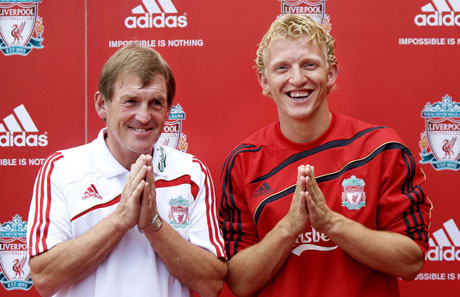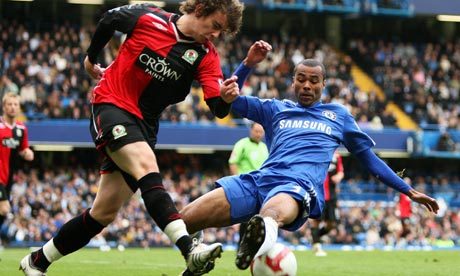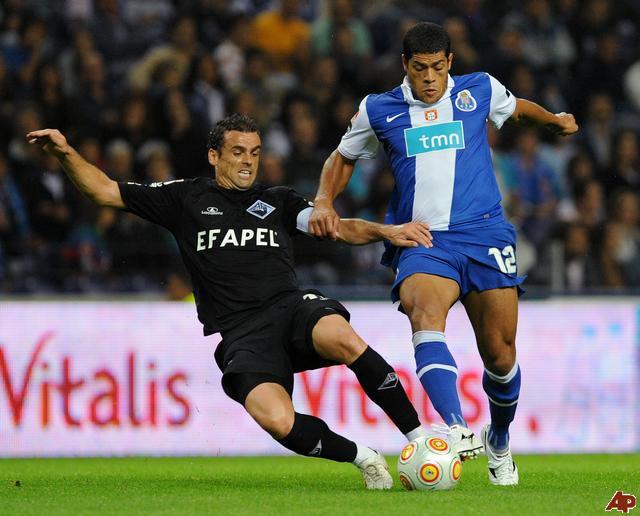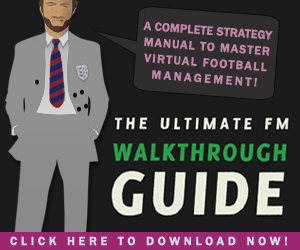-
Recent Articles
Understanding the 4-4-2 Diamond
DEFENCE Despite the fact that there are four ways to play a diamond formation on FM, the differences between them are few and usually subtle. As a starting point, one thing each of them do have...3 at the back and the 4-4-2 Diamond
 Last week Chelsea v Liverpool became the biggest tactical talking point of the season. Liverpool revived the the 3 man defence that Kenny debuted against Stoke. While with the introduction of Torres for £50m...
Last week Chelsea v Liverpool became the biggest tactical talking point of the season. Liverpool revived the the 3 man defence that Kenny debuted against Stoke. While with the introduction of Torres for £50m...How To Set Up A Back Four
 Last year, I wrote a guide about how to play a simple 4-4-2. One of the major components of that is the back four. In fact, most modern formations build upon four defenders; two full backs and two centre...
Last year, I wrote a guide about how to play a simple 4-4-2. One of the major components of that is the back four. In fact, most modern formations build upon four defenders; two full backs and two centre...Building Your Defence: Full Backs
 The modern full back is quickly becoming one of the most important players on the team sheet, infact even back in the days of Brian Clough, fat ed' argued that because of the space these players get in the final...
The modern full back is quickly becoming one of the most important players on the team sheet, infact even back in the days of Brian Clough, fat ed' argued that because of the space these players get in the final...False Nine Tactics
 When we think about modern football trends, we think about the fall of the 4-4-2, the introduction of inverted wingers and the rise of the 4-5-1. But there is one other tactical rise that seems to have...
When we think about modern football trends, we think about the fall of the 4-4-2, the introduction of inverted wingers and the rise of the 4-5-1. But there is one other tactical rise that seems to have...
JOIN 17,759 READERS - SUBSCRIBE NOW TO OUR FOOTBALL MANAGER NEWSLETTER
Get the latest FM news & best community content delivered directly to your e-mail inbox!
Tactical Bible ’08: Hold Up Ball
Written by: Matt vom Brocke
Category: Players
Posted on: August 12, 2007
August 12, 2007
Hold Up Ball
Where, why and when…
Hold Up Ball (HUB) is a great tool for giving your attacking play more structure. It’s uses are as varied as its effects, as different positions and different tactics will utilise HUB in different ways and for different purposes. How you use it will be affected by whether you’re attacking or defending and on what formation you choose.
Whether you choose to use it or not is obviously personal preference. Those who prefer slow-tempo systems may feel they don’t need HUB, since its primary use is to hold up the play for a few moments to pick better passes or to allow players to get into better positions. However, with a few key positions given this instruction, your side may become even more clinical and hold up the ball can become an essential part of your tactics. Higher-tempo systems may use it much more to dictate where on the pitch they are more patient and where they want to be more explosive.
HUB basically does what it says on the tin - the player will wait on the ball for a little longer than usual to give him and his team more time to choose the best course of action. It requires good decisions in order to work to the fullest effect, since it might encourage some players to “dawdle” on the ball and concede possession, especially against high-closing-down, hard-tackling teams. Sometimes, it’s best to run with the ball, or pass it first time. The player needs to be able to make this decision. You may also want to have strength, since HUB sometimes means that player will play with his back to goal and a defender on his back. A weak player will be easily bundled over and will lose the ball, whereas a stronger player may get a free kick or buy just enough time to play a killer pass and start a successful attacking move.
Below is a list of where we feel it’s best to use and best not to use HUB.
Defence (Fullbacks):
Fullbacks can be asked to HUB in conjunction with the “Counter Attack” team instruction and is suited mainly to defensive tactics. However, if playing a more attacking style having your fullbacks hold the ball may give them more time to search out the correct pass and will force the opposition to come to you for the ball. You may have to watch out if using HUB on fullbacks as the rest of the team may well run on ahead of the player with the ball only leaving him with 30-yard passing options. As with most players who use HUB, decisions will be an important attribute to consider, since dawdling on the ball at DL or DR may well give the opposition the perfect opportunity to launch a quick counter.
Midfield:
The DM:
Generally HUB can be very useful for DMCs in counter-attacking and defensive tactics since the DM can hold the ball in the middle of the field while your more attacking players get forward. However, it can also be great for attacking tactics, giving the play a more controlled feel. The DMC will keep the ball in the centre and look for the right pass. It may also encourage the opposition to come out of their proverbial “fortress” as they will have to close you down to get the ball. This should provide more space, better passing options and it should give your forwards a little more room if the opposition penalty area isn’t flooded with defenders. Normally, however, this role in the attacking tactics is performed by a holding MC rather than the DMC since the DMC is mainly involved in defensive duties and may get caught dawdling on the ball, leaving the defence very exposed.
The MC:
Very similar to the DM, the holding MC (MCd) can use HUB to make the play more patient and look for the right passing opportunities. The MC will also be further forward than a DMC, reducing the damage that might be caused by the player losing the ball under pressure. The MC will also be more likely to be in a position to take a long shot, which gives you an extra option in games where the opposition are making it difficult to get goals. It would be inadvisable to use the more attacking MC (MCa) for HUB, as this player needs to be more mobile and explosive, in general.
Wingers:
In the 4-5-1/4-3-3 and 4-2-3-1 system with AML/Rs and a single striker, HUB is useful in all situations except for extremely defensive tactics on the wingers, since it gives the players more time on the ball. This can lead to more incisive crosses and passes, increasing the quality of chances. Good decisions will be needed by the wingers, since clearly it may be better in some situations to run with the ball than hold it up. Usually, HUB will not stop the winger from ever running down the wing, but it may make him think about other options.
In the more traditional 4-4-2 (with ML/Rs rather than AML/Rs) HUB should really be restricted to attacking tactics in order to entice the opposition out of their shell. However, as these players are, in general, playing deeper than AMs, holding the ball up may leave the wingers too deep to cause any effective damage.
Attack
Fast Striker (Target Man)
Having the fast striker hold up the ball might seem like a contradiction in terms, but it may encourage him (providing he has decent decision making skills) to look for other options than simply running in the rough direction of the goal keeper. HUB may give him more passing opportunities, bringing the midfield and his striker partner into play and giving a wider range of attacking options. Of course, it won’t stop him running at goal if he’s in a one-on-one situation, but it may stop him “running into a brick wall”, so to speak if the opposition are effectively blocking him out of the game.
Strong Striker (Target Man)
This is the most traditional use of HUB. The strong striker can hold the defenders off while his team mates run on ahead for that killer ball. Having “Try Through Balls” set to “often” will only make this better.
In both cases, please read the target man article which will give you further ideas as to how to get the best out of HUB and your strike force.
For more information on setting up striker settings please read the TM article (link).
No, no, no!
It might sound obvious, but we strongly advise you not to use HUB on centrebacks and goalkeepers for obvious reasons. If these guys get tackled, chances are that you’ll lose a goal. HUB needs to be used in lower-risk areas of the pitch.
You should be careful using HUB if combined with an extremely slow tempo and maybe even high time wasting.
Tactical Bible credits:
The next Diaby, Millie, wwfan, garyh. Edited by: Millie
About The Author: Matt vom Brocke
Matt’s contribution to FM-B as a whole and the tactical area in particular cannot be over-estimated. The writer of the very well-recieved Communication and Psychological Warfare and Creativo set of tactics, Matt is a key member of the Tactical Think Tank and part of SI’s beta testing Dream Team.
Download Our Tactical Theorems '10 eBook Absolutely Free

Presenting the most comprehensive tactic design and match strategy guide to the Football Manager series ever created!
Written by FM match engine beta testers, it's 60+ pages of easy-to-read concepts and ideologies for getting your team playing exactly how you want each match! It's been downloaded over 100,000+ times to date!
Find out more information about our tactical eBook
and download Tactical Theorems '10 right now!
Written by FM match engine beta testers, it's 60+ pages of easy-to-read concepts and ideologies for getting your team playing exactly how you want each match! It's been downloaded over 100,000+ times to date!
and download Tactical Theorems '10 right now!




